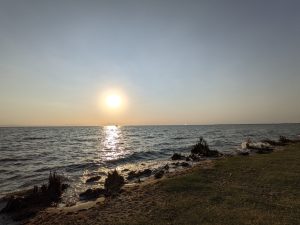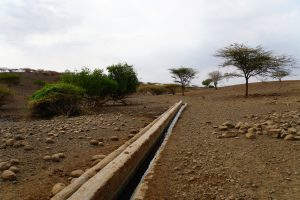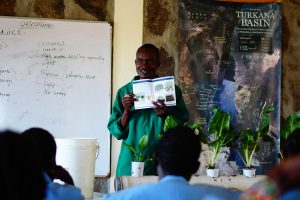Climate change manifests everywhere, even in Northern Kenya
Climate change. As one of the biggest topics of our time, its impacts are felt around the globe. The good news is that today most of us are aware of it, which is already quite a success. From the schoolteacher in Germany, to the banker on Wall Street, to farmers and herders in Kenya, it is present – in the news, in political debates, in stock markets, in farmers’ harvests, and even in the raising of livestock.
The consequences and effects are visible to everyone, reflected in the natural environment around us. They are expressed in the burning forests in Australia, extreme floods or droughts in Germany, hurricanes in the US, and dying animals in Kenya. It is often about water. Either too much or too little. All at once or nothing at all. Too early or too late.
While climate disasters in developed countries received global news coverage, this is not the case for climate change effects felt in Northern Kenya.

Lake Turkana – water is there, but can’t be used
The WE4F East Africa Hub share their on-the-ground experiences of these impacts collected during a field visit in July 2021 and the results of continuous conversations between the WE4F-implementer GIZ and its partner Turkana Basin Institute (TBI), based on the Eastern shore of Lake Turkana in Ileret.
Illeret, a Region in Northern Kenya Thirsty for Fresh Water
Water is the major challenge in Northern Kenya. Even in the Turkana Lake Basin, water is an issue. Due to its salinity, high levels of fluoride, and pollution, the lake water cannot be used for drinking or agricultural purposes. So, people rely on the few freshwater sources that can be found by intermittently digging holes in dried riverbeds. Additionally, the groundwater (with the exception of a few freshwater sources) has a very high fluoride content, making its untreated consumption impossible.
WE4F East Africa Hub staff visited lleret in July 2021. As they travelled, they saw women were sitting on the side of a dusty road in the shade of one of the few trees to be seen.

A watering place fed by a solar pump – one of the few water resources for livestock in the region
Equipped with jerrycans to catch water, they were waiting for a truck to pass to give them a lift closer to the nearest source of freshwater, too far away to walk. Sometimes they spend hours waiting or must return the next day. Now, with the ongoing drought, access to freshwater resources is becoming more difficult.
Lack of water equals lack of harvest. The only alternative? Livestock.
Horticultural crop production in an arid and semi-arid land region is impossible. Around Ileret, people have tried on several occasions to grow vegetables but had to abandon their efforts after multiple failed harvests. As a result, livestock production is the main income generator.
However, the reliance on livestock creates additional challenges when drought strikes. What can goats eat after they consume the last remaining leaves within their reach? How can cows graze on barren land?
The immesnse value of the animals is apparent in the herds of goats guarded by young boys equipped with nothing but a stick and the groups of cows being led to solar water pumps by herders with automatic rifles. The value of livestock, and how quickly conflicts can escalate, reflects the harsh conditions. Though nearly everyone knows about climate change and its causes and effects, not everyone feels the impacts as intimately as those here and it is clear, the water crisis can no longer be ignored.
“The drought in Ileret is really bad. The livestock die off has been massive, and now water sources are being threatened. The few fresh boreholes near Ileret have dried up. The other boreholes we looked at have such high electrical conductivity I can’t believe the water is potable. The shallow wells in dry riverbeds are also diminishing. This leaves the lake as sole water source, which is a disaster, because ironically the level has come up and submerged the dead animals on the shore. The water is basically carcass soup.” – TBI project officer, January 17. 2022
Against this backdrop, the partnership between WE4F and the TBI started in October 2020 to support local hydroponics entrepreneurs in Ileret. First, a solar-powered reverse osmosis system was installed to ensure adequate water supply to the institute as well as the hydroponic systems in the community. Then, twelve young people from Ileret participated in an extensive 4-month long hydroponic training before building their own systems, where they can now grow vegetables. Through this initiative, WE4F and TBI aim to increase the resilience of people in Ileret living in harsh conditions by giving them the tools to grow nutritious food, strengthening local food security, and providing an additional source of income.
Even under the current drought, the solar pump gets water from the ground. The reverse osmosis system delivers treated fresh water that keeps the hydroponic systems running and that is partially provided to the local community. While the current drought or droughts in general can’t be influenced by the TBI or the local community, they can at least work out strategies to more adapt to them. The use of hydroponics could be one of them.

Treated water is used for water-efficient hydroponic systems

Local youth from Ileret are getting trained to set up their own systems
Want to know more? Watch a Video on the partnership with TBI!
You can check out a mini documentary here to learn more about TBI and the project in Northern Kenya.
About the author:
 Kilian Blumenthal, Advisor in the WE4F East Africa Hub based in Nairobi, Kenya
Kilian Blumenthal, Advisor in the WE4F East Africa Hub based in Nairobi, Kenya
Contact: kilian.blumenthal@giz.de
Kilian holds a B.Sc. in Environmental Engineering of the HAW Hamburg and a M.Sc. in Agricultural Sciences in the Tropics and Subtropics of the University of Hohenheim. His academic research focused on Solar Water Pumping Systems in Bolivia and the Potential Use of Solar Energy in the Maize Value Chain in Benin. He has done numerous trainings on the SPIS Toolbox and gained experience during longer stays in South America and Sub Saharan Africa.

